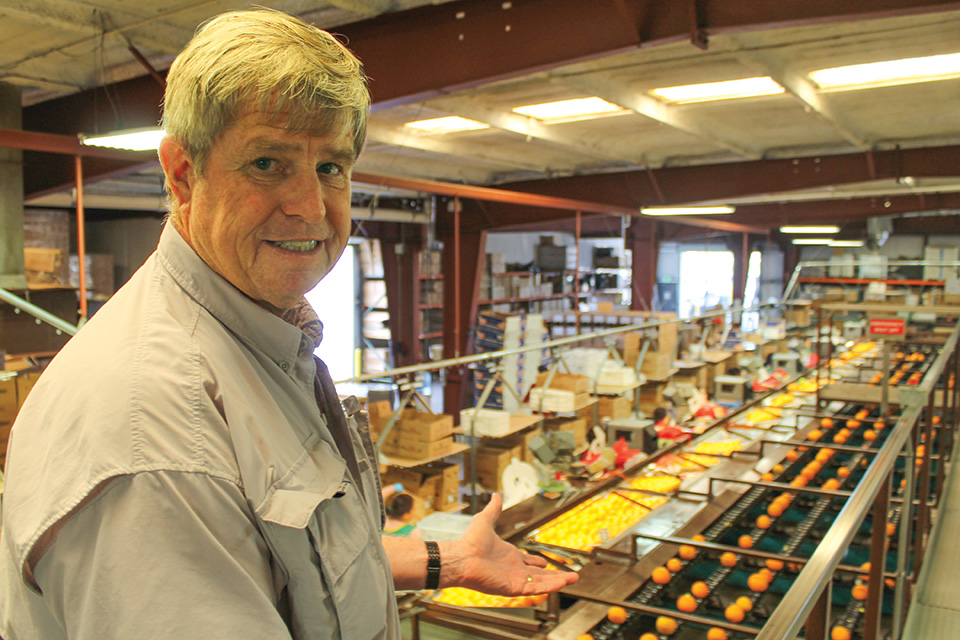Ways to Succeed in Organic Stone Fruit Production

Fruit is running through the Abundant Harvest Organics packinghouse. Sorting, Peterson says, is key to delivering high-quality organic fruit. (Photo: David Eddy)
For Vernon Peterson, a successful organic stone fruit farm means 265 acres primed to grow 50 varieties of stone fruit, from peaches and plums to apricots and nectarines.
“Your job is to supply all types of stone fruit, yellow peaches, white peaches, yellow nectarines, white nectarines, red plums, black plums, pluots, and apricots every week, for an entire season,” says Peterson of Abundant Harvest Organics and The Peterson Family Farm in Kingsburg, CA.
Peterson, who ventured into organic farming in 2002, has been farming his whole life. In 2017, he was honored as the Organic Grower Summit’s Grower of the Year. The Peterson family has been farming in Kingsburg for about 125 years. The San Joaquin Valley’s deep, well-drained soil, high-quality water, cool winters, and dry summers make it an ideal region for stone fruit production.
Today, besides a wide variety of stone fruit, Peterson grows citrus and persimmons. He also raises organic chickens.
“In order to farm organic fruit, soil is your No. 1 concern,” he says. “If you get your soil right, the trees will resist quite a few diseases.”
Consistency is Key
Another critical element in providing a consistent, quality supply of stone fruit, Peterson says, is a steady supply of labor.
“Our crew works year-round, pruning, thinning, harvesting, and [engaging in] orchard maintenance. [We] clean up our orchards with a biological herbicide called ‘shovel,’” jokes Peterson. “Seriously, we use a shovel to clean out Johnson grass.”
But perhaps even worse than not having many herbicides is the lack of available insecticides.
“Oriental fruit moth and peach twig borer can be controlled with pheromone disruption,” Peterson says. “We purchase and release predatory mites in our orchard. Six-spotted thrips are also very effective. The enemy of our enemy is our friend.”
Peterson says it is necessary to sort fruit grown in an organic orchard for quality, just as one would in a conventional orchard. Much of the sorting occurs in the packing facility.
“On a typical lot, we will send about 10% of the ‘cosmetically challenged fruit’ to be sold more cheaply. We also send this fruit to processing outlets. The fruit I don’t have a market for goes to cows.
A neighbor with a feed lot comes and picks that up. He never rejects anything,” he says.
Transition to Organics
Abundant Harvest converted to organic farming as the stone fruit industry was experiencing a huge washout.
“Many growers dropped out of producing between 1998 and 2010. Retail consolidation caused us to go from selling to hundreds of grocers and marketers to selling to a dozen of them,” Peterson says.
Peterson says the transition to organic farming was made easier by the fact that he was already producing organic fertilizers from the chickens.
“We did this (the transition to organic) not to save the planet, but to save the farm. One of the hardest parts was waiting. You have to wait three years and one day to sell as an organic farm. This translated into us having to start farming organically while selling (the fruit) as conventional,” Peterson says.
Peterson says communication with neighbors is important.
“Our neighbors know we’re organic. But they’re not. We have buffer rows of fruit that we sell as conventional. You can’t sell the fruit as organic if it’s too close to areas where other farmers are using [conventional] pesticides,” Peterson says.
Organic Production Nuances
Peterson says it is helpful to have a trustworthy partner to sell the fruit.
“Homegrown Organic Farms is our marketer. They sell our fruit all over North America to supermarket chains or regional wholesalers. We produce fruit that sells from the first of May to the end of September. One-fourth of the fruit goes to Canada, while the rest goes to the U.S.,” he says.
Peterson says an organic stone fruit orchard should last about 20 years.
“Usually, we replant 5% of our acreage every year. When we let land lie fallow for a year, we plant sudangrass to grow on the land. With 5% replaced annually, the best we can be is 85% of full production if we never make a mistake,” Peterson says.
Giving Back
Peterson says he values the fact that running Abundant Harvest allows him to contribute to the community.
“I’ve been on the board of the Kingsburg Community Assistance Program (KCAP) for 30 years,” he says. “This is an organization that consists of all the churches in Kingsburg working together to meet the needs of the poor. KCAP staff comes every day to pick up boxes of fruit and give it away.”
Peterson says he also works with the Center for Land-Based Learning, an agricultural education center based in Winters, CA.
“We have students that come out every year to see us. They visit the fields and the packing shed, spending a little bit of time learning how we pick, pack, and tag fruit,” he says. “I love to share what works.”
Peterson’s secret for success has been maintaining a positive attitude.
“If we all do a better job, we’re all going to sell more,” he says. “I am for an abundance mentality, not a shortage mentality.”
Finally, Peterson says one thing you have to get right in stone fruit farming is choosing the correct varieties.
“A variety of a stone fruit is usually only good for a week. I’m always looking to see if there’s something that could be better than what we are growing,” he says. “Since you’re going to live with your choice for 20 years, you search for the most incredible varieties. You want to pick and grow the most flavorful, attractive, and durable fruit you can find.”










